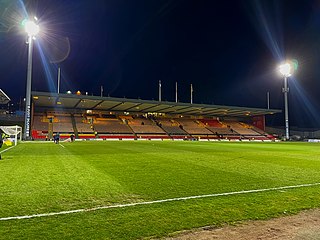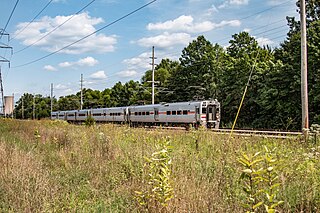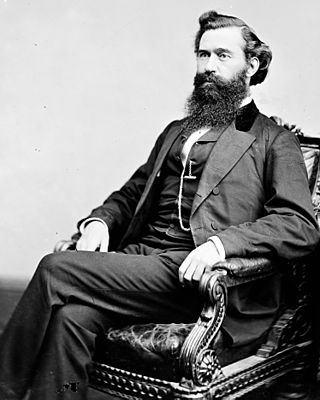Related Research Articles

Marcus is a town in Stevens County, Washington, United States. The population was 216 at the 2020 census.

Michiana is a region in northern Indiana and southwestern Michigan centered on the city of South Bend, Indiana. The Chamber of Commerce of St. Joseph County, Indiana defines Michiana as St. Joseph County and "counties that contribute at least 500 inbound commuting workers to St. Joseph County daily." Those counties include Elkhart, La Porte, Marshall, St. Joseph, and Starke in Indiana, and Berrien and Cass in Michigan. As of the 2020 census, those seven counties had a population of 867,747.

Revelstoke Dam, also known as Revelstoke Canyon Dam, is a hydroelectric dam spanning the Columbia River, 5 km (3.1 mi) north of Revelstoke, British Columbia, Canada. The powerhouse was completed in 1984 and has an installed capacity of 2480 MW. Four generating units were installed initially, with one additional unit (#5) having come online in 2011. The reservoir behind the dam is named Lake Revelstoke. The dam is operated by BC Hydro.

Firhill Stadium, also known as Wyre Stadium at Firhill for sponsorship reasons, is a football and former rugby union, rugby league and greyhound racing stadium located in the Maryhill area of Glasgow, Scotland which has been the home of Partick Thistle since 1909.

The South Shore Line is an electrically powered interurban commuter rail line operated by the Northern Indiana Commuter Transportation District (NICTD) between Millennium Station in downtown Chicago, Illinois and the South Bend International Airport in South Bend, Indiana, United States. The name refers to both the physical line and the service operated over that route. The line was built in 1901–1908 by predecessors of the Chicago South Shore and South Bend Railroad, which continues to operate freight service. Passenger operation was assumed by the NICTD in 1989, who also purchased the track in 1990. The South Shore Line is one of the last surviving interurban trains in the United States. In 2023, the system had a ridership of 1,406,900, or about 5,400 per weekday as of the second quarter of 2024.

The Big Bend of Florida, United States, is an informally named geographic region of North Florida where the Florida Panhandle transitions to the Florida Peninsula south and east of Tallahassee. The region is known for its vast woodlands and marshlands and its low population density relative to much of the state. The area is home to the largest single spring in the United States, the Alapaha Rise, and the longest surveyed underwater cave in the United States, the 32-mile (51 km) Wakulla-Leon Sinks cave system.
The Big Bend Gold Rush was a gold rush in the Big Bend Country of the Colony of British Columbia in the mid-1860s.
Donald is an unincorporated community in the East Kootenay region of southeastern British Columbia. This almost ghost town is on the northeast shore of the Columbia River immediately southeast of the mouth of Marl Creek. The locality, on BC Highway 1, is by road about 28 kilometres (17 mi) northwest of Golden and 122 kilometres (76 mi) northeast of Revelstoke.

Jasper Packard was an American attorney, Civil War veteran, and politician who served as a member of the United States House of Representatives for Indiana's at-large congressional district and Indiana's 11th congressional district.

The era of steamboats on the Arrow Lakes and adjoining reaches of the Columbia River is long-gone but was an important part of the history of the West Kootenay and Columbia Country regions of British Columbia Canada. The Arrow Lakes are formed by the Columbia River in southeastern British Columbia. Steamboats were employed on both sides of the border in the upper reaches of the Columbia, linking port towns on either side of the border, and sometimes boats would be built in one country and operated in the other. Tributaries of the Columbia include the Kootenay River which rises in Canada, then flows south into the United States, then bends north again back into Canada, where it widens into Kootenay Lake. As with the Arrow Lakes, steamboats once operated on the Kootenay River and Kootenay Lake.
Dalles des Morts, also known as Death Rapids in English, was a famously violent stretch of the Columbia River upstream from Revelstoke, British Columbia, Canada, now submerged beneath the waters of Lake Revelstoke.

The Forty-Nine was a steamboat that operated from the mid-1860s to the early 1870s in today's West Kootenay region of southeastern British Columbia.
Boat Encampment is a ghost town in the East Kootenay region of southeastern British Columbia, Canada. The locality was at the tip of the Big Bend on the north shore of the Columbia River. The general vicinity, on the former Big Bend Highway, was by road about 151 kilometres (94 mi) northwest of Golden and 159 kilometres (99 mi) north of Revelstoke.

Lytton was a sternwheel steamboat that ran on the Arrow Lakes and the Columbia River in southeastern British Columbia and northeastern Washington from 1890 to 1904.
In the Canadian province of British Columbia, Big Bend Country is the region around the northernmost section of the Columbia River, which changes from a northwestward course along the Rocky Mountain Trench to curve around the northern end of the Selkirk Mountains to head southwest between that range and the Monashee Mountains, which lie to the west. The area is part of the larger Columbia Country, which includes the Columbia Valley and upper Arrow Lakes of eastern British Columbia. The 2,300 square miles (6,000 km2) north of the railway line, and enclosed by the river, roughly defines the Big Bend. However, in earlier eras, the descriptive was more narrowly understood.
William Alexander Mouat was a British seafarer. Born in London, he spent much of his career with the Hudson's Bay Company in British Columbia on the west coast of Canada. He became master of several merchant ships including the Otter and the Labouchere. His last posting was at Fort Rupert where he died in a canoe accident. He was married to Mary Ann Ainsley and they had eight children.
Alaska 1741–1953 is a book written by Clarence C. Hulley, published in 1953.
HMCS Porte de la Reine was a Porte-class gate vessel of the Royal Canadian Navy.
Harry Bruce Johnston was a Canadian politician, who served in the Legislative Assembly of British Columbia.
Downie Creek is in the West Kootenay region of southeastern British Columbia, Canada. Surrounded by the Selkirk Mountains, the creek is a tributary of Lake Revelstoke, part of the Columbia River. On BC Highway 23, the highway bridge is by road about 69 kilometres (43 mi) north of Revelstoke.
References
- ↑ Bilsland, William W. (April 1955), A History of Revelstoke and the Big Bend, University of British Columbia, p. 38, retrieved 2019-09-30
- ↑ "First Trip of the Steamer Forty-Nine", The Daily British Colonist, vol. 15, no. 137, Victoria, p. 3, May 23, 1866, retrieved 2019-09-29
- ↑ Bilsland 1955, p. 19.
- ↑ Bilsland 1955, p. 30.